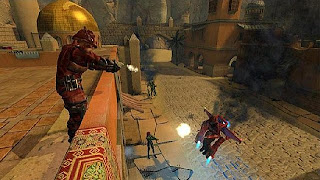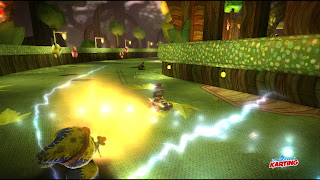We're twelve days into August without our first review of the month. We change that with Game & Wario, a late June release for the Nintendo Wii U. How does this mini-game collection hold up? Here's our review to find that answer out.
Wario's Got Game-- And Lots of Them!
Wario debuted in 1992 as Mario's fellow plumbing nemesis in Super Mario Land 2: 6 Golden Coins. While nowadays Mario has continued to be involved in platforming adventures of both the 2D and 3D varieties, Wario, rather than returning to the genre he was known for, has sat back and made loads of money off of creating his own video games. That tradition continues with Game & Wario, a mini-game collection that might seem light on content at first, but as the old adage says, "You shouldn't judge a book by its cover." While not a game that is a killer app for the Wii U, it is a worthy party game to look into. After all, Wario's gotta pay those bills somehow!
There are sixteen unique activities to try out in Game & Wario, twelve of which are only aimed for a solo experience. The latter four are meant for multiplayer gaming. The two favorites in the multiplayer games are Sketch and Island. Sketch is basically Game & Wario's version of Pictionary, tasking one player to draw the word that is displayed on the Wii U GamePad, away from the guessers' view. When they have successfully named what the drawer's word is, the drawer hits the correct button and moves onto the next word. If the guesser(s) have a hard time figuring out what the drawer is trying to convey (or if he or she just plain can't draw worth a hill of beans), then the drawer can hit the pass button, though this subtracts twenty seconds out of the two minute time frame. Sketch is just a hilarious party game to play with friends and family, and there are so many words that repeats don't really become a problem for a long while.
The other multiplayer game that the SuperPhillip Central crew and their friends and family enjoyed most is Island, where you fling a handful of cubed creatures known as Fronks onto floating targets for points. Not only is skill required to aim correctly to get huge points and to knock off your opponent's Fronks, but luck also plays a factor in the game. There are four different maps to play on, each with their own novelty. Using the Wii U GamePad to have one's finger draw back the slingshot to fire the Fronks at the targets is quite novel, as is moving the controller to arc one's shot.

The twelve solo games use the Wii U GamePad in various ways. Some use the touch screen, some use the gyro motion controls built inside the GamePad, some require you to look at both the Wii U GamePad and television screens, and some use a combination of the three. Unfortunately, you have to play the mini-games in the solo mode's intended order. However, all that is required in each mini-game is to clear the first level. Then, you can happily move onto the next game. As you can imagine, this means you can technically "beat" all of the mini-games and see the credits in about an hour's time. That notwithstanding, there are multiple stages to clear in game, and mastering said stages earns you tokens, which can be spent in a gift exchange, offering over 200 unique interactive gifts to collect.
As for the games themselves in solo mode, they range from great to poor. I'll talk about the ones that were enjoyable for me to start off. Arrow is the first mini-game available, and it has you holding the Wii U GamePad vertically and using the touch screen to fire shots at moving targets that inch closer closer to you. Taking out multiple enemies with one shot nets the greatest amount of points, a must-have to master the four stages Arrow consists of.
Ski is something that should be very familiar to those who have played Nintendo Land's Captain Falcon's Twister Race. Like Arrow, you hold the GamePad vertically, but this time you tilt the controller to the left and right to move the character safely through the slopes. Although there is eye candy on the television screen, you really don't get a chance to look at it, as your main focus should be the Wii U GamePad screen, which displays the lay of the land ahead of the character.

Kung Fu is one of my favorite solo mini-games, as it requires you to alternate your attention between the TV screen and the Wii U GamePad's screen. The TV screen shows what's coming ahead while the Wii U GamePad shows an overhead view, perfect for seeing where the aspiring Kung Fu master is about to land (or in many cases, fall). Your character is constantly making large leaps into the air, and by shifting the GamePad forward, you can move him from platform to platform, all the while collecting dumplings and scrolls to boost the remaining time. There are five stages in Kung Fu, and the game has some of the most impressive visuals, reminding me heavily of Okami.

Gamer is also one of my favorite solo mini-games. It stars 9-Volt, a boy who just can't get enough video games. He plays them during the day, and he even plays them at night when he's supposed to be sleeping. Gamer focuses on playing micro-games on the Wii U GamePad, like the ones seen in the WarioWare series, while keeping a close eye on the television screen to hit the button to slide underneath the covers and pretend to be asleep when 9-Volt's mom peeks in. The harder difficulties add different ways that his mom can enter the room unannounced, such as popping her head out of 9-Volt's TV. Truly scary stuff!

Taxi is the third mini-game requiring your attention to both the Wii U GamePad and television screens. The TV screen will show an overview of the map, while the GamePad screen shows a first-person view. The goal here is to pick up fares and drop them off at a marked destination. Meanwhile, you need to shoot down UFOs that arrive all over the map to boost your score. It gets pretty crazy, but the controls (including the gyro motion of the GamePad) work well, offering an experience that isn't as frustrating or confusing as it might sound.
Unlike many of the other mini-games in Game & Wario, Patchwork and Design are the types of game that really don't use the Wii U GamePad in an innovative way. They could be done on the DS or any other touch screen-possessing device. That said, they're still rather fun, especially Patchwork. It's a collection of 90 or so puzzles that have you piecing together differently-shaped patches on top of a grid. The end result will make some type of object, similar to how a Picross puzzle starts out as an unexceptional grid and ends with a picture of a well-known object. The medium difficulty adds in multiple places for certain patches to fit on the grid. However, it is possible to put a patch in the wrong place, making it impossible to complete the puzzle without changing its position.


Design is the other game that could be done on another platform. It measures how well you follow instructions and estimations of distance. For instance, one trial will ask you to draw a triangle with 3 inch sides. The closer you are to making that perfect triangle, the more points you receive. As you proceed with Design, the instructions and tasks get more difficult, such as drawing a squiggly 12 inch line.
Now for the games that don't work as well or just aren't that much fun. Shutter is part of the latter group, and has you holding the Wii U GamePad in front of you like a camera, zooming in on "targets" and trying to take photos of their faces. The catch is that there are many non-targets, and you have to frame each target perfectly to earn the most points. The annoyance with Shutter is that you have to move the GamePad forward and downward to "give" your photo your boss. This means you have to get your bearings all over again and move the camera back to its original position.
Ashley is what I would call a throwaway game. It's essentially a shoot-em-up that automatically shoots for you. Where's the fun in that? This is all while you tilt the Wii U GamePad at different angles to change Ashley's direction. Along the way, Ashley defeats enemies that drop magic (basically points) to collect. The best thing I can say about this boring mini-game is that it's only three stages long.
Pirates is Wario's themed game, and it is just a mess. It requires you to block arrows from multiple sides and in multiple directions. The issue here is that the calibration of the Wii U GamePad gets thrown off easily, meaning you have to pause and fix it mid-game, and even then there are no guarantees you'll be good to go. Pirates is easily the worst mini-game in Game & Wario, but thankfully it's simple enough to clear the first time.
Game & Wario isn't a title that will make Wii U owners rush to stores to buy copies of. It has a niche on the system, however, for Wii U owners who would like to see more intuitive and creative uses out of the Wii U GamePad controller. There's some depth in some mini-games that isn't readily apparent at first glance. That said, it's easier to make the case that Game & Wario should have been a pack-in title for the Wii U instead of a separate retail release, even at its budget price of $39.99 MSRP. Regardless, the majority of the mini-games are winners, and if Nintendo Land isn't enough for your pick-up-and-play parties, then Game & Wario should fill that hole quite nicely.
[SPC Says: 7.0/10]


















































